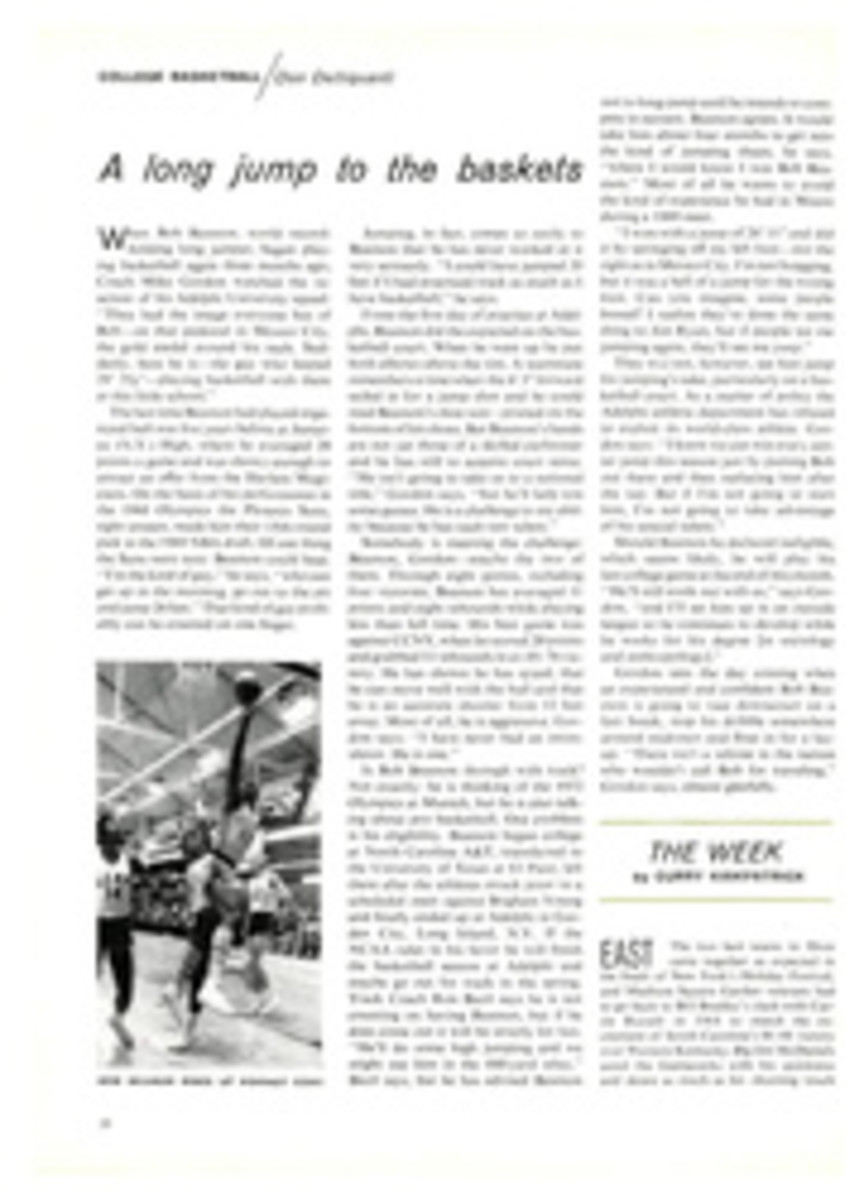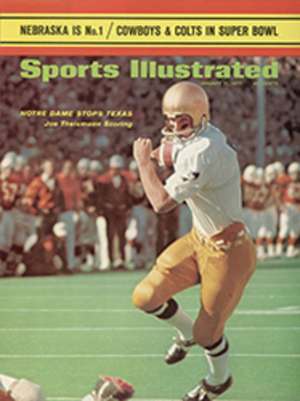
What every well-bred rookie should know
As professional golf's 1971 pursuit of gold and glory begins this week in Los Angeles, the corpus of the tour—those 250-odd players who try to make their living at the game—begins again its annual rite of renewal. It does this by an uncomplicated act of attrition and rebirth: the old, the infirm and the un-gifted fall by the wayside as the tour grinds its 35,000-mile way toward next December. And standing ready to take their places is a platoon of young, healthy and clearly gifted youngsters on whom the PGA's Tournament Players Division has bestowed its most coveted prize—a brand-new player's card.
Of course, these youngsters—18 of them this year—face the same hardships and perils as their veteran companions, and a few besides. For instance, getting there in the first place. Qualifying for the school, traveling to it and paying the entry fee, not to mention expenses for the seven-day session, could set back the average rookie (or his hometown sponsor) $1,500. But if early results are any indication, the 1971 rookie crop—mostly Americans but with a sprinkling of Aussies, New Zealanders and one Italian, Roberto Bernardini—seems promising at least. In three tournaments since earning their cards in Tucson at the PGA players school last November, the new pros have earned an aggregate of about $10,000. Brian Allin actually led a tournament for one day, and five players have finished in the money at least once. One of them, Vic Loustalot, took home a $7,350 paycheck for third place at Coral Springs.
An explanation for this early blush of success may be the fact that they were taught so well. The TPD's Tucson session, and the ones that have preceded it for six years, gives these youngsters a savagely realistic taste of what professional pressure really is. Unlike the average tour event, where perhaps 80 of the players who qualify make money, the recent players school weeded out all but 18 over the 72 holes of competition. For the rest of the 60-man class of 1970, there was nothing.
Though the golf at Tucson was pretty good and the competition fierce the PGA does not tout the event as the Rabbit Open or some such. In fact, the competitive aspects are generally played down, even in the official title, which is the Qualifying School for PGA Approved Tournament Players. The school itself is really two afternoons' worth of lectures heavily laced with pieties and euphemisms of the sort that big industry often inflicts upon its recruits in the name of orientation or adult education. The similarity is so close that at times it seems that the PGA might really be IBM or GMC, and the 60 golfers the firm's brightest trainees brought together at a country club so that they can hear a lot of gingery lectures on loyalty, dedication and the virtues of old-fashioned competition.
The young golf pros even look a good bit like young IBMers. Herded into the club's dining pavilion, they are all conservatively dressed in ties and coats—because they have been told to so dress—carefully barbered, quiet, mannerly, smiling, being, in general (to use a quaint old phrase), as clean-cut a group of young men as one is likely to see in these troubled times. They also appear very earnest, listening wakefully, even taking notes as a variety of officials tell them how to get on the tour and how to behave after they get there.
People who run things, whatever they are, tend to believe that the world would be a better, more profitable place for all if underlings were undeviatingly obedient, predictable and respectful. In essence, this is what the 60 young golfers are told in various ways. The message is repeated so often that Don't Rock the Boat or, less elegantly, Keep Your Nose Clean might have served as the motto for the 1970 school.
The first speakers were two old parties, Leo Fraser and Warren Orlick, respectively the immediate past and current presidents of the PGA. They told the boys that wiser heads than theirs established the traditions of competitive golf, that golf is a wonderful, public service sort of profession, that there are great opportunities ahead of them. More specifically, they warned the boys not to bitch about exemptions, the golfing tradition by which stars are automatically permitted to play in big tournaments while unknowns must qualify competitively.
Three clean-cut golfers, Dave Stockton, Dale Douglass and Tommy Jacobs, were introduced as young men who have made it, like salesmen who have sold 300% of quota. The three successful professionals advised the class to develop repeating golf swings, remember the names of as many club members as possible and avoid bad company.
Joe Schwendeman, the tour's head publicity man, told them the press corps is very important to the tour and that as a rule it is manned by honorable men, but that it does not do to gripe to reporters or in places where reporters are likely to hear you.
Joe Dey, the commissioner of the tour, and Jack Tuthill, the tour director, came on as the two top working executives of the outfit. Dey, the world's premier golf administrator and a man in whom a will of iron is modestly covered by a diplomat's suavity, told the boys he was thrilled to see such a fine group, that he knew they would be a credit to the game of golf and to the competitive, free enterprise system. He advised them not to sign contracts with equipment manufacturers or sponsors without legal consultation, to pay all their bills promptly and know the rules of golf well.
Tuthill is another tough cookie, but, unlike Dey, does not need—or perhaps does not care—to cover up his iron. Tuthill speaks in an early George Raft style, a soft, sinister whisper out of the corner of his mouth. A disingenuous student asked Tuthill why so much of the purse of each tournament goes to the winner, so little to the also-rans. "Members at my club ask me if it wouldn't be better to spread it out a little, so more people can make a living, and I don't know how to answer them," said the unfortunate rookie.
"That is a good point," mumbled Tuthill. "The answer is don't talk to outsiders about things like that."
The climactic lecture turned out to be a good old-fashioned camp-meeting sermon, delivered by Richard Crawford, a touring professional from Arkansas, who said he went 14 weeks on the tour without a paycheck until he accepted Jesus Christ as his personal Savior. Since then he has been a much happier man and a better golfer. He urged members of the class who get their cards to attend the Tuesday-night Bible readings that he helps conduct on the tour. Also, it emerged, Richard Crawford represents a men's clothing manufacturer, and he invited the boys to sign up with his firm.
At times the classes at the qualifying school were fairly heavy going, but the main points seemed to be made. There were, as everywhere, a few dissidents. One brash young Texan said of the school, "Well, you can slice it anyway you want, but the reason we're here is spelled m-o-n-e-y." Fortunately for the administrators—he had all the markings of a boat rocker—the Texan did not play as well as he talked, and he finished out of the money.
More typical of both the students and the tone of the PGA school was Bob Clark, one of the most promising graduates of the class of '70. Clark is a good-looking, 23-year-old blond from California. He has no worries about sponsors, since his father and uncle, both business executives, will support him on the tour. He is friendly, articulate, obviously intelligent. He is well on his way to developing a beautiful, tight, repeating golf swing. Since his days in the juniors, he has planned, as another might for medicine or nuclear physics, for a career as a touring professional. ("It's corny, but I just love the game.")
He selected his college, California State at Los Angeles, because of its heavy golf schedule, and from that school won the NCAA individual championship in 1969. He practices four or five hours a day. Other interests? Well, he has dabbled in the stock market a bit....
Bob Clark is a very straight arrow and there is not a bit of the pop off or boat rocker about him. "I guess I'm not much of an entertainer, like some of them," Clark says, without much apparent regret. "I like people and I hope they like me. I'd like to be respected for the quality of my golf."
Based on the evidence of Tucson, there seems to be a fine chance that Clark will fulfill many of his career ambitions. Without any heroics, though he was putting poorly, Clark hung near the leaders of the qualifying tournament for the first three rounds. On the last day, when the serious pressure was turned on, Clark kept himself very much together, avoiding trouble most of the time, and when in it, playing out conservatively. ("Eighteenth is as good as 1st here," he said coolly and correctly.) He dropped a few long putts on the payoff day and came in with a thoroughly disciplined, intelligent, gutsy 70 to finish the tournament five under par, in second place behind Bob Barbarossa, another cool, college-trained (University of Houston) 23-year-old.
If skill, temperament and caring mean anything, it would seem that Clark, Barbarossa and several others of the class stand a good chance of joining the ranks of the solid, if not starring, professionals. It is not hard to imagine either one of them returning to tell the qualifying school of, say, 1975 how to make it on the tour, as Dave Jacobs (or was it Tommy Stockton?) had.
There is perhaps one other point worth mentioning in connection with the qualifying school. Despite their virtues as golfers and decent young men, neither Clark nor Barbarossa were the ones who most involved and caught the imagination of the small gallery at the Tucson event. That honor went to Charles Owens. Like most of the others, Owens was a neat, polite, friendly fellow, but otherwise he was much different from the model of the perfect young professional. Charles Owens is a 33-year-old black man—a crippled man, having as a paratrooper smashed his left leg so badly that the knee joint had to be fused by surgery. ("They say keep your left side firm," smiled Owens. "Well, with me, no problem.") Finally, as the eccentricity to end all of them, Owens plays cross-handed, real cross-handed, his left hand lowest on the shaft.
Everyone was rooting for Owens at Tucson, and it was not simply because he was a figure of sympathy. He is also an exciting golf player, being a big man, an ex-football player who hits the ball a ton off the tee, fighting it from there determinedly if not elegantly into the cup. So it was when Owens limped in, dragging his stiff leg, on the last afternoon with a 286, good enough for 10th place and a players card, there was a general feeling that a very good thing had happened, good for Charles Owens, good for those watching, maybe even good for the almighty tour.
TWO PHOTOS
QUALIFIERS : Bernardini (left) and Allin earned their passports to golfing's riches (below).

